
Land art is a term originating in the art world of the 1960s. Also called earth art or earthworks, land art was born from a combination of reaction to the increasingly commercialized and commodified nature of art and environmental activism. Land art has remained popular throughout the decades and you can find many famous examples all over the world. To understand more about land art, here are the basic elements you need to know.
While most forms of art are meant to last forever, land art is unique in its ephemeral nature. Land art installations only last a short amount of time because of natural processes. Some examples include intricate drawings in sand on a low-tide beach or sculptures built out of snow. When the tide comes in and the air warms up, these art pieces will fade away. However, there are some permanent examples of land art that have already lasted decades, such as Robert Smithson’s “Spiral Jetty” in the Utah salt flats. The key factor is that land art must exist outside of established art spaces like museums. If it’s inside a building, it’s no longer land art.
Another key tenet of the land art movement is use of natural materials. Stone, water, fallen tree branches, leaves and ice are common examples. Land art might also include natural elements from the animal world like feathers, shells, animal bones or furs. Some artists and critics insist on this rule and claim that land art using other materials like textiles or metal means the art is no longer “land art.” However, there is overlap between land art and environmental art, which seeks to draw attention to or comment on natural phenomena. These pieces frequently include materials like concrete and metal and string or glue to hold components together.
While there can be some debate over the actual materials used in land art, one aspect artists agree on is the importance of location. Land art is always created for and in a specific place in nature and must stay there throughout its “life.” Sometimes, specific characteristics of a site may play a huge role in the art itself. For example, land art may depend on rising or lowering water levels, the angle of the sun, direction of wind or even the local flora and fauna. This is the most dramatic contrast with traditional art displayed in galleries or museums and can make the art less accessible when set up in remote locations. However, the opposite is also true: many regard land art as a more accessible art form because it does not require visits (or payments) to museums or galleries.
Like any art movement, land art has many facets and interpretations. These key elements are the most important things to remember when seeking or creating land art of your own.

Kim Clark started her real estate career in 1999 and shortly thereafter obtained her Broker’s license in 2002. After working for larger, corporate offices, she realized that her business and clients needed a more personalized and flexible firm. She founded Bayside Realty Consultants in 2007 offering a space of unity, collaboration and encouragement for agents and their clients. Kim specializes in the unique Cape Cod market comprised of primary, vacation and investment properties.
She says "It is great to be a part of helping make a homeowner's dreams come true". Clients and their individual needs can make things very exciting! Kimberly's enthusiasm is contagious and it has been a real asset in her successful career. She says, "Never quit. Just do what you like and the rest just falls into place." She is certified in several real estate designations including GRI, CBR, CRS, e-Certified, and a certified trainer.